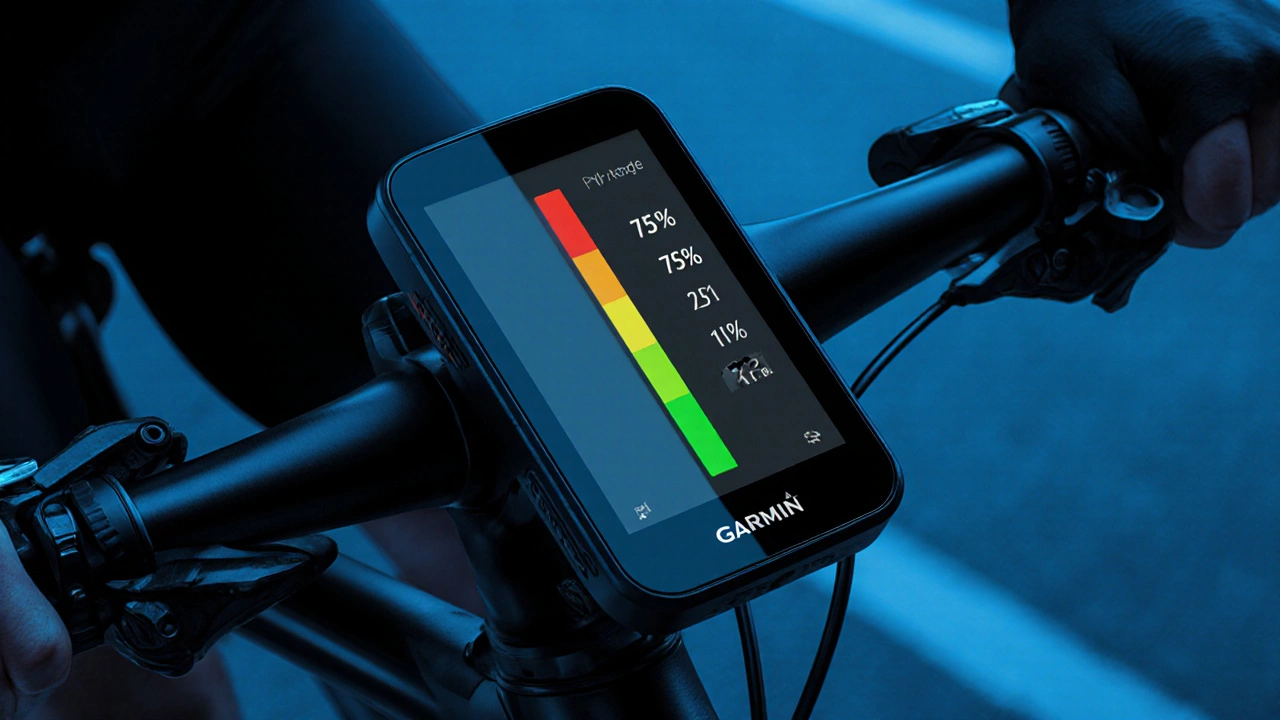
Cycling October 9, 2025
75 Rule in Cycling Explained - What It Is and How to Use It
75 Rule Calculator
Understanding the 75 Rule
The 75 rule suggests keeping 75% of your training time at lower intensities (below 75% of your Functional Threshold Power or FTP) and 25% at higher intensities. This calculator helps you visualize your training distribution.
Your Training Distribution
% of your time is at easy intensity (< 75% FTP).
% of your time is at hard intensity (> 75% FTP).
Training Zones Overview
| Zone | % of FTP | Typical Feel | Role in 75% Rule |
|---|---|---|---|
| Zone 1 (Active Recovery) | ≤55% | Very easy, can hold a conversation | Counts toward the 75% easy mileage |
| Zone 2 (Endurance) | 55–75% | Steady, moderate breathing, sustainable for hours | Core of the 75% rule |
| Zone 3 (Tempo) | 75–85% | Comfortably hard, you can speak in short sentences | Upper edge; occasional rides may enter here |
| Zone 4 (Threshold) | 85–95% | Hard, breathing deep, you can’t sustain long | Part of the 25% hard work |
| Zone 5+ (VO₂ Max & Sprint) | >95% | Very hard, short bursts | Focused interval work within the 25% block |
When cyclists talk about the 75 rule is a training guideline that recommends keeping roughly 75% of your rides below a specific intensity threshold, usually 75% of your Functional Threshold Power (FTP) or heart‑rate zone. The idea is simple: most of your mileage stays easy enough to build endurance, while the remaining 25% pushes you into harder work that improves strength and speed.
Why the 75% Threshold?
Most riders discover that staying under 75% of FTP feels sustainable for long periods. At this intensity, lactate production stays low, allowing you to ride for hours without choking on fatigue. The body still burns a decent amount of calories, trains the slow‑twitch muscle fibers, and improves blood flow. By contrast, riding above 90% of FTP quickly spikes lactate, forces you into an anaerobic state, and can only be sustained for a few minutes.
Key Metrics Behind the Rule
Three metrics drive the calculation:
- Functional Threshold Power (FTP) is the highest average power you can hold for an hour, measured in watts. Typical club cyclists have an FTP between 150W and 250W.
- Heart‑rate zones reflect the percentage of your maximum heart rate. Zone2 usually aligns with 60‑70% of max HR, which mirrors the 75% power target for many athletes.
- Cadence is the pedal revolutions per minute. While cadence doesn’t directly set the 75% level, staying in a comfortable 80‑95rpm range helps maintain the intended intensity.
How to Set Up Your Bike Computer
Modern bike computers make it easy to track the 75% rule in real time. Devices like the Garmin Edge combine power‑meter data, heart‑rate monitoring, and GPS to calculate your current intensity as a percentage of FTP. After pairing the unit with a power meter and a heart‑rate monitor, you can set a custom data field that shows "%FTP". Whenever the number dips below 75%, the screen stays green; crossing the line triggers a yellow warning, and a red alert appears above 90%.

Applying the Rule: A Step‑by‑Step Routine
- Determine your FTP. A common test is a 20‑minute all‑out effort, then multiply the average power by 0.95.
- Calculate 75% of that value. For a rider with a 200W FTP, the target is 150W.
- Plan a weekly schedule that keeps at least three‑quarters of your total ride time under this power.
- Use your bike computer to monitor %FTP throughout each ride. Adjust gear selection to stay within the zone.
- Reserve the remaining 25% for interval sessions, hill repeats, or race‑pace efforts that exceed 90% of FTP.
Following these steps consistently prevents overtraining, reduces injury risk, and still offers enough hard work to spark performance gains.
Training Zones Aligned with the 75% Rule
| Zone | % of FTP | Typical Feel | Role in 75% Rule |
|---|---|---|---|
| Zone1 (Active Recovery) | ≤55% | Very easy, can hold a conversation | Counts toward the 75% easy mileage |
| Zone2 (Endurance) | 55‑75% | Steady, moderate breathing, sustainable for hours | Core of the 75% rule |
| Zone3 (Tempo) | 75‑85% | Comfortably hard, you can speak in short sentences | Upper edge; occasional rides may enter here |
| Zone4 (Threshold) | 85‑95% | Hard, breathing deep, you can’t sustain long | Part of the 25% hard work |
| Zone5+ (VO₂ Max & Sprint) | >95% | Very hard, short bursts | Focused interval work within the 25% block |
Common Misunderstandings
Many cyclists think the 75 rule means “ride at exactly 75% of FTP all the time”. That’s not the case. The rule is about distribution, not a fixed power. You can have a long 2‑hour zone‑2 ride at 65% FTP and still satisfy the guideline as long as the total proportion of easy versus hard work stays around 75/25.
Another myth is that you must hit 75% on every training day. In reality, a rest day or a short high‑intensity drill doesn’t break the rule; it’s the aggregate over a week or a month that matters.

Adjusting the Rule for Different Goals
If you’re training for a ultra‑endurance event, you might push the easy proportion up to 80% and keep the hard block at 20%. Conversely, a sprinter targeting short, explosive power could flip the ratio to 65% easy and 35% hard, still keeping the core idea of balanced stress.
Age and fitness level also matter. Younger riders with high recovery capacity can tolerate a slightly larger hard share, while older cyclists often benefit from a more generous 75‑plus easy percentage.
Tracking Progress Over Time
To see whether the 75 rule is working, pull a weekly summary from your bike computer or training platform. Look for:
- Total minutes spent below 75% FTP.
- Average power and heart‑rate trends across the easy rides.
- Performance gains in FTP tests after 4‑6 weeks.
If your easy mileage consistently hits the target and your FTP improves, the rule is doing its job. If you notice lingering fatigue, reduce the hard block and bring the easy share up.
Real‑World Example: A 4‑Week Plan
Imagine a rider with a 210W FTP. Here’s how a balanced month could look:
- Week 1: 4×2‑hour endurance rides at 60‑70% FTP (easy), plus 1×interval session of 4×5‑minute efforts at 95% FTP (hard).
- Week 2: 3×3‑hour rides staying under 75% FTP, 2×short hill repeats at 100% FTP.
- Week 3: Recovery week - 2×1‑hour easy rides, rest days, no intervals.
- Week 4: Test week - a 20‑minute FTP test, then evaluate the %easy vs %hard distribution.
This schedule respects the 75‑percent rule while giving enough stimulus for performance jumps.
Frequently Asked Questions
What does the 75 rule actually measure?
It measures the proportion of your training time that stays below roughly 75% of your Functional Threshold Power (or the equivalent heart‑rate zone). The goal is to keep about three‑quarters of rides easy, reserving the remaining quarter for harder work.
How do I find my FTP?
A popular method is the 20‑minute test: ride all‑out for 20 minutes, record the average power, then multiply by 0.95. Many training apps can automate the test and calculate FTP for you.
Can I use the 75 rule without a power meter?
Yes. Use a heart‑rate monitor and aim to stay below 70‑75% of your max heart‑rate (roughly Zone2). It’s less precise than power, but still captures the easy‑vs‑hard balance.
What if I’m training for a sprint race?
You can shift the ratio to about 65% easy and 35% hard, focusing the hard blocks on high‑intensity interval training (HIIT) that pushes above 95% FTP. Keep the easy rides in Zone2 to aid recovery.
Is the 75 rule suitable for beginners?
Absolutely. In fact, beginners benefit most from the high‑percentage easy riding because it builds a solid aerobic base without overwhelming fatigue.




